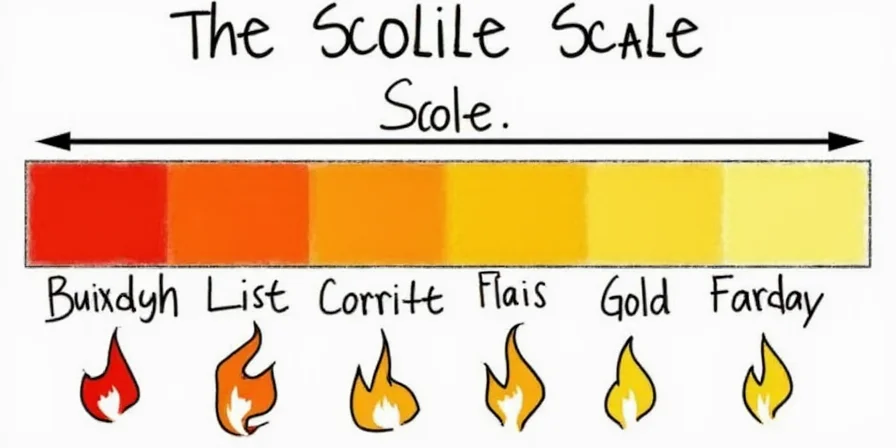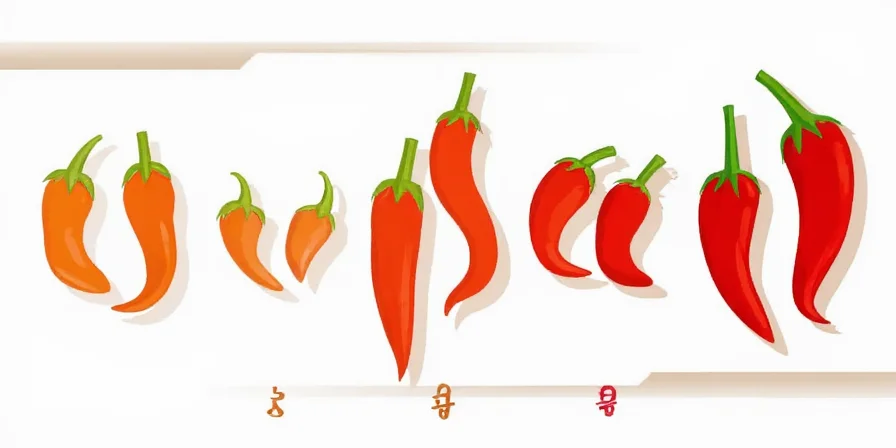Looking for the definitive Scoville scale chart showing pepper heat levels from mild bell peppers to Carolina Reaper? You've found it. This science-backed reference ranks 20+ chili varieties by Scoville Heat Units (SHU), includes safety protocols for handling superhots, and explains why heat perception varies between people. Skip to the complete pepper heat table below or use our quick reference guide for common cooking scenarios.
| Pepper Name | Heat Level (SHU) | Quick Reference Guide | Visual |
|---|---|---|---|
| bell pepper | 0 | Sweet crunch - safe for kids |  |
| pepperoncini | 100–500 | Mild tang - salad staple | |
| jalapeño | 2,500–8,000 | Tex-Mex standard - remove seeds to reduce heat |  |
| serrano | 10,000–23,000 | 2x hotter than jalapeño - salsas & sauces |  |
| habanero | 100,000–350,000 | Fruity & fiery - handle with gloves |  |
| ghost pepper (Bhut Jolokia) | 855,000–1,041,427 | Extreme heat - use ⅛ tsp instead of 1 habanero |  |
| carolina reaper | 1,400,000–2,200,000+ | World's hottest - emergency milk nearby |  |
Why This Scoville Scale Chart Is Different
Most online pepper heat guides oversimplify Scoville ratings. This reference accounts for three critical factors that change real-world heat experience:
- Natural variation: A single jalapeño plant produces peppers ranging from 2,500-8,000 SHU based on sunlight and water stress
- Preparation method: Dried peppers concentrate capsaicin—1 tsp cayenne equals 4 fresh serranos
- Biological differences: Genetic variants make some people 3x more heat-sensitive than others
Immediate Safety Protocol for Peppers Over 50,000 SHU
Professional kitchens follow these non-negotiable rules when handling habaneros and hotter:
- Gloves are mandatory: Use nitrile (latex offers zero protection against capsaicin)
- Emergency kit ready: Keep 2% milk solution (not water) for skin/eye exposure
- No-touch workspace: Designate one knife/board exclusively for superhots
- Ventilation required: Exhaust fans needed when cutting—capsaicin becomes airborne above 100,000 SHU

Practical Pepper Substitutions by Heat Level
Replace unavailable peppers without ruining your dish:
- For mild recipes (0-500 SHU): Banana peppers → Pepperoncini (similar tang)
- For medium heat (2,500-8,000 SHU): Serrano → Jalapeño (use 2x quantity)
- For hot recipes (50,000-100,000 SHU): Thai bird's eye → African peri-peri (similar heat, citrus notes)
- For extreme heat (100,000+ SHU): Ghost pepper → Trinidad Scorpion (use 75% quantity)
Why Identical SHU Ratings Feel Different: The Science
Two peppers with identical Scoville ratings can produce dramatically different experiences due to:
- Genetic sensitivity: TRPV1 receptor variants make some people perceive heat as 3x stronger
- Cultural conditioning: Populations with generational spice exposure develop physiological tolerance
- Heat distribution: Capsaicin concentrates in placenta (white ribs)—seeds contain minimal heat
Quick Heat Neutralization Guide
What to use when your mouth is on fire:
- Most effective: Whole milk or yogurt (casein dissolves capsaicin)
- Good alternative: Peanut butter or avocado (fats absorb capsaicin)
- Avoid: Water (spreads oil-based capsaicin), alcohol (increases absorption)

Frequently Asked Questions
How hot is a ghost pepper compared to habanero?
A ghost pepper (855,000-1,041,427 SHU) is approximately 3-8x hotter than a habanero (100,000-350,000 SHU). Use just ⅛ teaspoon of ghost pepper powder to replace one habanero in recipes.
Does cooking reduce pepper heat?
Capsaicin is heat-stable but redistributes during cooking. Up to 30% degrades after 2+ hours through evaporation, not chemical breakdown. Never rely on cooking to significantly reduce extreme heat.
Why do some mild peppers occasionally burn intensely?
Environmental stress (drought, pests) triggers survival-mode capsaicin production. Always taste-test even typically mild varieties like poblanos before adding to dishes.
Can children eat spicy foods safely?
Yes, with precautions. Introduce mild peppers (1,000-5,000 SHU) during weaning to build tolerance. Avoid superhots—children's thinner mucous membranes increase burn severity by 40%.
How to store hot peppers safely?
Freeze superhots in airtight glass containers (capsaicin permeates plastic). Label clearly and store separately from regular produce. Never use the same cutting board for superhots and other foods without thorough cleaning.
Real-World Pepper Heat Application Guide
Use this quick reference for common cooking scenarios:
- Taco night: Jalapeños (2,500-8,000 SHU) - remove seeds for milder flavor
- Thai curry: Bird's eye chilies (50,000-100,000 SHU) - never substitute with milder peppers
- Hot sauce: Habaneros (100,000-350,000 SHU) + mango for balance
- Dare challenge: Carolina Reaper (1.4M-2.2M+ SHU) - use only 1 drop of extract

Final Safety Reminder
Peppers above 100,000 SHU (habanero and hotter) require professional handling protocols. The world's spiciest edible pepper (Dragon's Breath at 2.48 million SHU) can cause respiratory distress. Always prioritize safety over heat challenges—true culinary skill lies in controlled spice application, not extreme heat.











 浙公网安备
33010002000092号
浙公网安备
33010002000092号 浙B2-20120091-4
浙B2-20120091-4